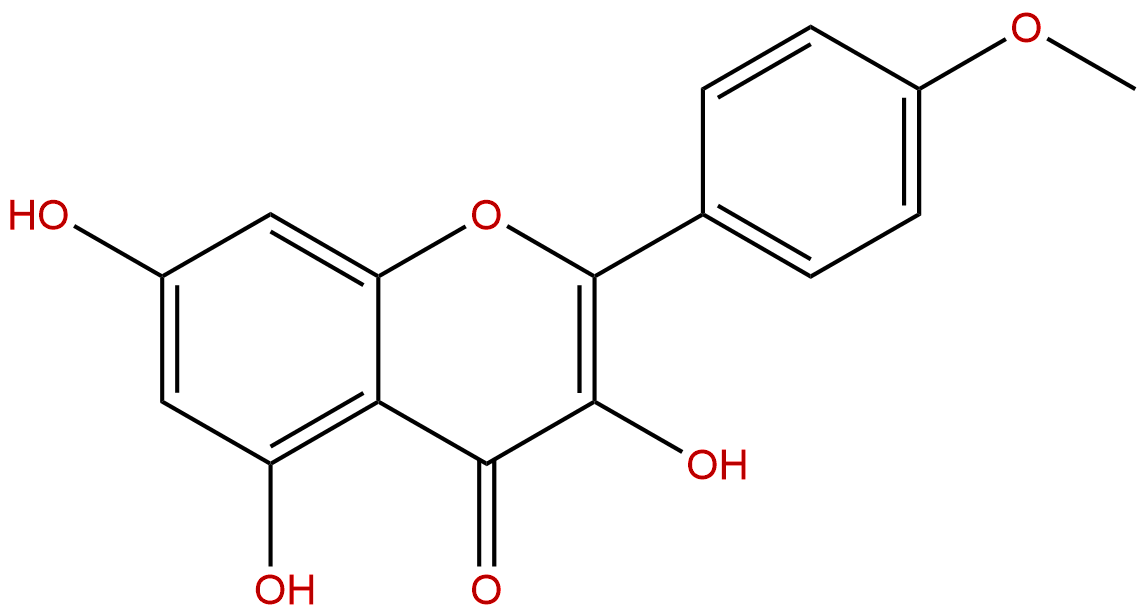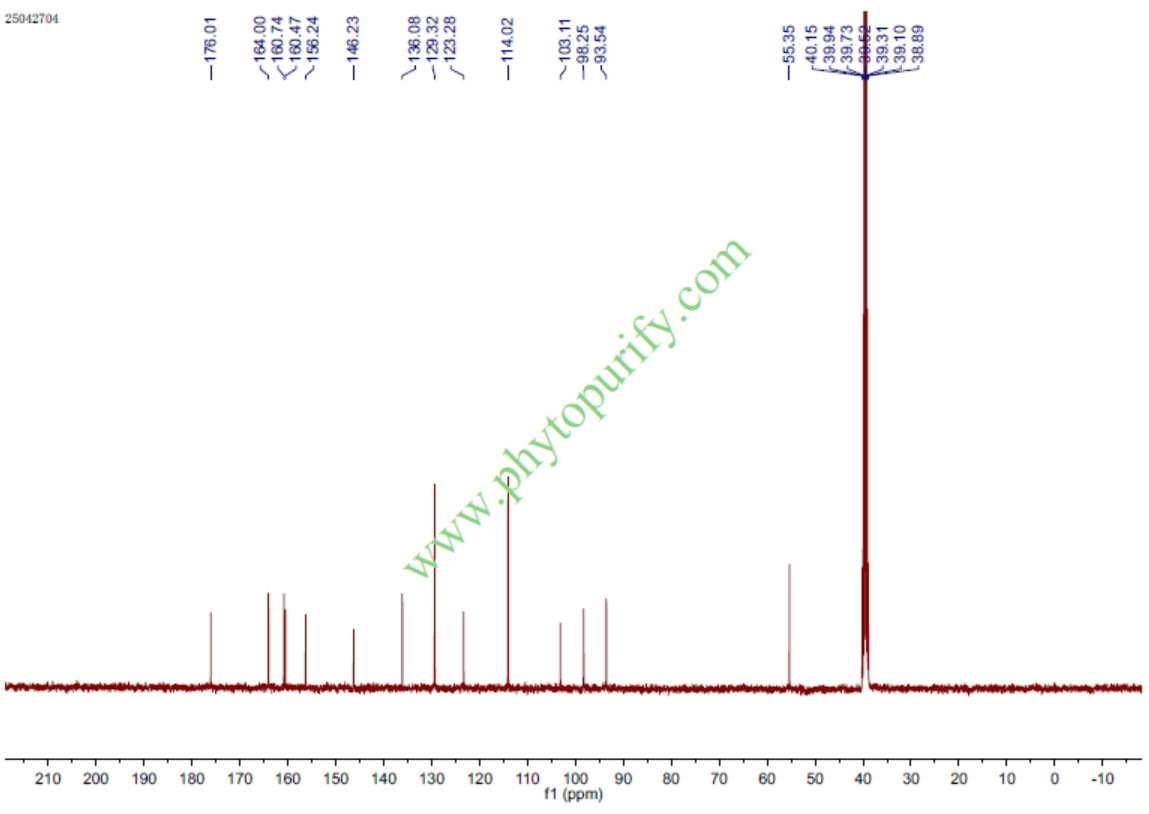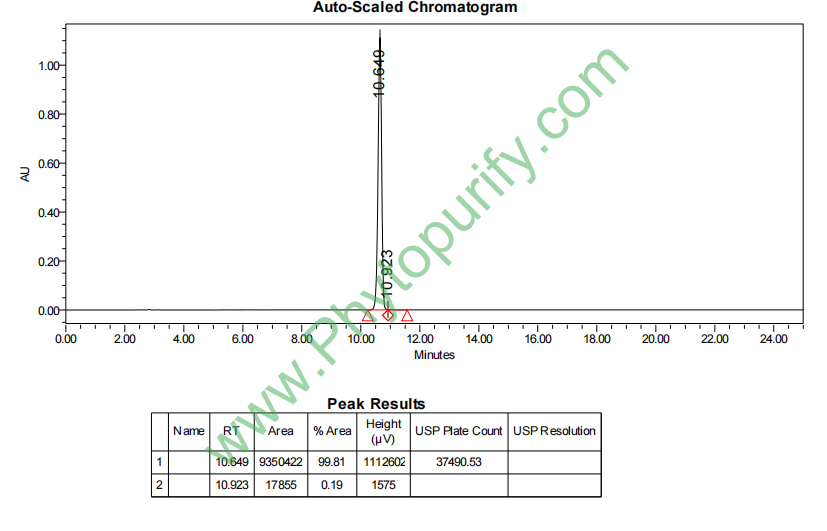
KaempferideCAS No.:491-54-3
|
||||||||||
 |
|
|
||||||||

| Catalogue No.: | BP0817 |
| Formula: | C16H12O6 |
| Mol Weight: | 300.266 |
Synonym name: 5,7-Dihydroxy-4'-methoxyflavonol; Kampheride; Campheride
Catalogue No.: BP0817
Cas No.: 491-54-3
Formula: C16H12O6
Mol Weight: 300.266
Botanical Source: many plant spp. First isol. in 1839 from roots of Alpinia officinarum (lesser galangal)
Purity: 95%~99%
Analysis Method: HPLC-DAD or/and HPLC-ELSD
Identification Method: Mass, NMR
Packing: Brown vial or HDPE plastic bottle
Can be supplied from milligrams to grams.
For Reference Standard and R&D, Not for Human Use Directly.
Inquire for bulk scale.
Description:
Kaempferide has a variety of effects including anti-carcinogenic, anti-inflammatory, anti-oxidant, anti-bacterial and anti-viral properties.it can protect DNA from radiation induced lesions resulting from radiation exposures under in vitro and ex vivo conditions.
References:
Yao Xue Xue Bao. 2012 Jul;47(7):890-6.
Comparison of effects of kaempferide and anhydroicaritin on biomineralization of cultured osteoblasts
This study is to compare the effects of Kaempferide and anhydroicaritin on biomineralization of rat osteoblasts (ROB) in vitro.
METHODS AND RESULTS:
Calvarias were dissected aseptically from newborn SD rats, the osteoblasts were obtained by enzyme digestion and were cultured in MEM containing 10% FBS. The medium was changed every three days, and serial subculture was performed when cells covered with 90% of the dish. Kaempferide and anhydroicaritin were separately added with final concentrations of 1 x 10(-4), 1 x 10(-5), 1 x 10(-6) and 1 x 10(-7) mol x L(-1) under the conditions of osteogenic differentiation. The proliferation was measured by MTT, and the optimal concentration was detected by the ALP activity at the 9th day after osteogenic induction culture. The osteogenic indexes of Kaempferide, anhydroicaritin and control group with the optimal concentration were compared. The result showed that the anhydroicaritin at concentration of 1 x 10(-5) mol x L(-1) had significantly promoted the activity of ALP, calcium content and osteocalcin content, increased the number of CFU-F(ALP) and mineralized nodules, enhanced the mRNA level of BMP-2, OSX and Runx-2, which are key genes of osteogenic differentiation, and raised the protein content of collagen-I. However, the Kaempferide group had not significantly represented the ability that promoted osteogenic differentiation of ROB.
CONCLUSIONS:
The difference of osteogenic differentiation on ROB between Kaempferide and anhydroicaritin was caused by the prenyl group on C-8 of icariin.
Int.J.Radiat. Res.,2013, 11(2):81-9.
Antioxidant capacity and radioprotective propertiesof the flavonoids galangin and kaempferide isolated from Alpinia galanga L. (Zingiberaceae) against radiation induced cellular DNA damage
Alpinia galanga L belonging to the family Zingiberaceae is widely grown in the state of Kerala, India. They are effective antioxidant and free radical scavenger under both in vitro and in vivo condition. The efficacy of the isolated flavonoids in conferring protection from radiation induced damages to genomic DNA was studied.
METHODS AND RESULTS:
The bioflavonoids, galangin and Kaempferide were isolated from the AE fractions Alpinia galanga. The isolated flavanoids - galangin and Kaempferide, and the crude extracts (AE and EE) were assayed for their various free radical scavenging activities like DPPH (1,1-diphenyl-2-picryl-hydrazyl), hydroxyl and superoxide radical scavenging activities. The in vitro DNA damage was monitored by assessing the radiation induced relaxation of supercoiled plasmid DNA (pBR 322). Damage to cellular DNA of human peripheral blood leukocytes induced by y-radiation (4 Gy) was monitored by alkaline single cell gel electrophoresis or comet assay. The extracts and pure compounds scavenged hydroxyl radicals in a concentration dependent manner. The compounds demonstrated a concentration dependent scavenging capacity by neutralizing the superoxide radicals. A considerably lower concentration (400-1000 ppm) of the pure flavonoids showed good antioxidant capacity. The presence of 10 mM Kaempferide helped in reducing the extent of DNA damage following 4 Gy gamma irradiation (P<0.001). Galangin (10 mM) also facilitated in reduction of comet parameters.
CONCLUSIONS:
The extracts of Alpinia galanga or the isolated bioflavonoids -galangin and Kaempferide can protect DNA from radiation induced lesions resulting from radiation exposures under in vitro and ex vivo conditions.
NMR of Kaempferide

HPLC of Kaempferide
